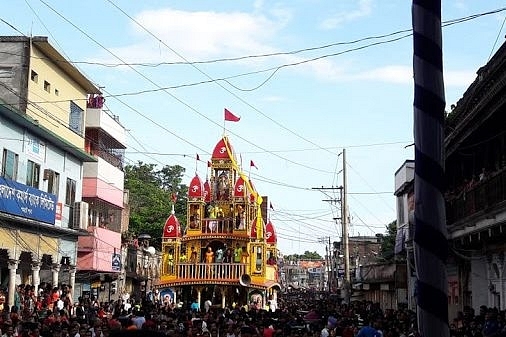Culture
How Pakistani Soldiers Burnt A Giant Rath And Stopped Its Yatra In 1971
- That act of sacrilege by the Pakistani army dealt a big blow to the famous Rath Yatra of Dhamrai.
- Today, a steel and timber chariot is in use, but the shadow of the destruction of the grand rath still looms over the festival.

The Dhamrai Rath Yatra.
The annual Rath Yatra at Puri, the seat of Bhagwan Jagannath, may be one of the most famous of its kind, but a chariot taller than the one at Puri used to form part of a Rath Yatra at a town by the name of Dhamrai in present-day Bangladesh. That was until 1971, when soldiers of the Islamist Pakistani army burnt down the rath and thus derailed the yatra.
The Rath Yatra at Dhamrai, a sub-division of Dhaka district, is believed to be more than 500 years old. The oldest records of the Rath Yatra there date back to 1672 and describe the chariot being a massive one made of bamboo. Devotees from even Nepal used to participate in the festival.
Sometime in the third decade of the nineteenth century, the zamindars of Baliati Saturia (now in Manikganj district near Dhaka) commissioned the construction of a massive wooden chariot for the annual Rath Yatra. Carpenters and artisans from Dhamrai and neighbouring towns toiled for over a year to build the chariot.
Once completed, the chariot was 60 feet tall, stood on a 45 feet x 45 feet base and moved on 32 giant wheels. The five-storey chariot used to be pulled by devotees from the Jashomadhav temple to Gopi Nagar temple half a kilometre away.
The chariot, which had two ornamental wooden horses, used to be pulled by thick jute fibre ropes weighing over a 1,000 kilograms. According to old accounts, devotees from all over Bengal, Odisha, Assam and even Nepal used to flock to Dhamrai to participate in the Rath Yatra and the month-long accompanying festival.
In comparison, the Nandighosha (the largest rath that carried Bhagwan Jagannath in Puri) is a little over 44 feet in height and sits on a 34.5 x 34.5 feet platform. The two other chariots — Taladhwaja (carrying Balabhadra) and Darpadalana (carrying Subhadra) — are a little over 43 feet and 42 feet respectively.
After the abolition of the zamindari in 1950 by the Pakistani government, Rai Bahadur Ranada Prasad Shaha, a rich businessman from Mirzapur (a town in north-central Tangail district of Bangladesh) extended generous support for the upkeep and maintenance of the giant chariot and for organising the annual Rath Yatra.
A philanthropist who established renowned educational institutions like the Bharateswari Homes (a boarding school for girls), Kumudini College and Debendra College, Shaha was picked up by the Pakistani Army in mid-April 1971 along with his 26-year-old son Bhavani Prosad Shaha. The duo were released in early May, but picked up again just a day later.
Nothing was ever heard of them after that and it was assumed that they had been killed by the Islamist Pakistani soldiers, who were engaged in an ethnic cleansing of Bengalis, especially Bengali Hindus. The cleansing was part of the genocidal Operation Searchlight in which an estimated 30 lakh people were killed and more than 4 lakh women raped. About one crore people fled to India.
Not content with murdering the patron of the Rath Yatra and his son, the Pakistani soldiers set fire to the massive chariot on 10 June 1971, just a fortnight before the yatra.
That act of sacrilege, and the pogrom against Hindus at that time, dealt a big blow to what was till then the world’s biggest Rath Yatra drawing tens of thousands of devotees.
The Rath Yatra resumed after a gap of two years in 1973, but its glory was lost. A chariot made of wood and bamboo was constructed and that lasted for a few years before another one was constructed.
In 2009, India offered help to build a wooden chariot. An MoU was signed between the then Indian high commissioner to Bangladesh Pinak Ranjan Chakravarty and the Jashomadhav Temple Management Committee that organises the annual festival.
The project was completed in 2010 and the new rath stands 40 feet tall, is set on a base measuring 27 feet x 27 feet and has 16 wheels (watch this video). It is three-storied and has four chambers in the first two floors and one chamber on the top floor; together, the chambers are called the navaratna (nine jewels).
This rath, made of steel and timber, has been in use since then. But once-famous festival at Dhamrai, which is also renowned for its bellmetal and brass items (watch this), no longer attracts the tens of thousands of devotees as in the past.
The shadow of the murder of its patron, and the destruction of the grand rath by Pakistani soldiers, still looms over the festival.
Support Swarajya's 50 Ground Reports Project & Sponsor A Story
Every general election Swarajya does a 50 ground reports project.
Aimed only at serious readers and those who appreciate the nuances of political undercurrents, the project provides a sense of India's electoral landscape. As you know, these reports are produced after considerable investment of travel, time and effort on the ground.
This time too we've kicked off the project in style and have covered over 30 constituencies already. If you're someone who appreciates such work and have enjoyed our coverage please consider sponsoring a ground report for just Rs 2999 to Rs 19,999 - it goes a long way in helping us produce more quality reportage.
You can also back this project by becoming a subscriber for as little as Rs 999 - so do click on this links and choose a plan that suits you and back us.
Click below to contribute.
Latest